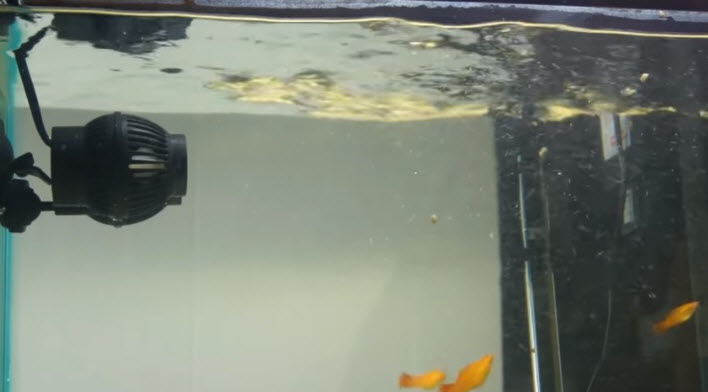
Some terminology needs to be clarified when it comes to submersible pumps commonly used inside the aquarium:
- Powerhead: originally a centrifugal impeller pump used to drive an under-gravel filter that drew in water through the bottom of the pump (vertically) and then expelled it from the side of the pump horizontally in a forceful concentrated flow.
- Circulation pump: a bladed propeller pump that is solely used to create water flow in the aquarium, giving a high rate of flow over a broad front.
- Wavemaker: an electronic device to which you connect, say 2 pumps, which then turns the pumps on and off intermittently, either together or alternately, giving the water a to and fro or side to side movement. This was really only useful in saltwater reef aquariums. But the term has now been broadened to include bladed circulation pumps.
Unfortunately, this terminology has been used interchangeably by many suppliers of these devices. This has resulted in a lot of confusion.
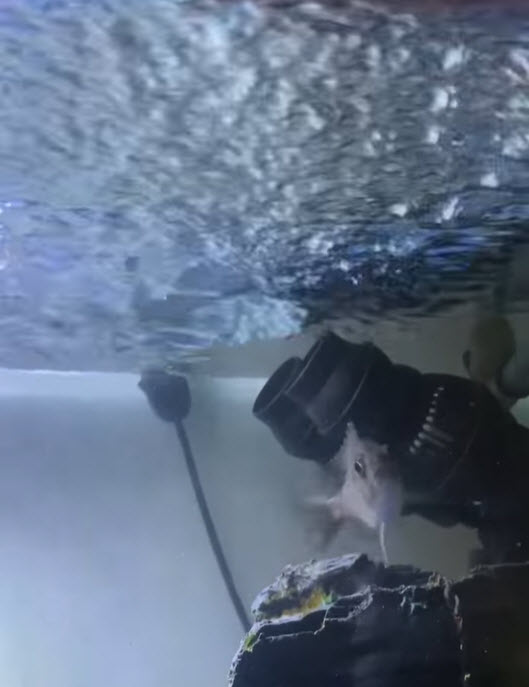
Bladed Circulation Pumps
The bladed circulation pumps or “wavemakers” are very useful in the aquarium. They create a lot of water current with a small amount of wattage. They serve two functions:
- They aerate the water very well if they are aimed at the surface in such a way as to create a choppy surface agitation. This type of turbulent flow is very effective at aeration and is vital in most heavily stocked aquariums that don’t have air stones.
- They can sweep the bottom of the aquarium free of unattractive feces and insure they get into the filter.
A good option is to use two bladed circulation 3 watt 500 GPH pumps per aquarium. Add one pump at the upper back side of the aquarium. Aim this at the surface in such a way as to maximize the choppy water surface area. Then add, at the side opposite the first pump, a bladed circulation pump at the back at a middle height, aimed at an angle to the middle front of the aquarium. This pump keeps the front substrate free of feces and mulm without being too obtrusive.
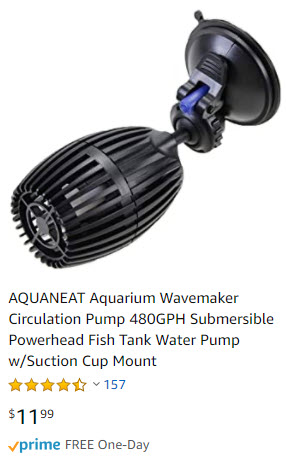
There seems to be some confusion with the above instructions so I’m going to try to get more specific:
- Take one bladed wavemaker and put it at the top back right side. Put it on the side glass as far back as it will go. Put it centered down from the water’s surface about five inches. Aim it slightly up (about 20 degrees) to maximize the choppy wave surface area. Aim it slightly to the front in line to hit the other wavemker on the other side of the aquarium.
- Take the second bladed wavemaker and put it on the dead center of the left side glass (dead center, if the piece of glass is 16 inches in height and 18 inches in width, then place the wavemaker at 8 inches in height and 9 inches in width) . Aim it towards the substrate in the front of the aquarium. Play around with the placement to maximize the mulm disturbance while keeping the wavemaker relatively out of sight. A stiff plant can cover it well.
Here are two drawings of the placement of the two wavemakers. The first is the view from the front of the tank and the second is the view from the top of the tank:
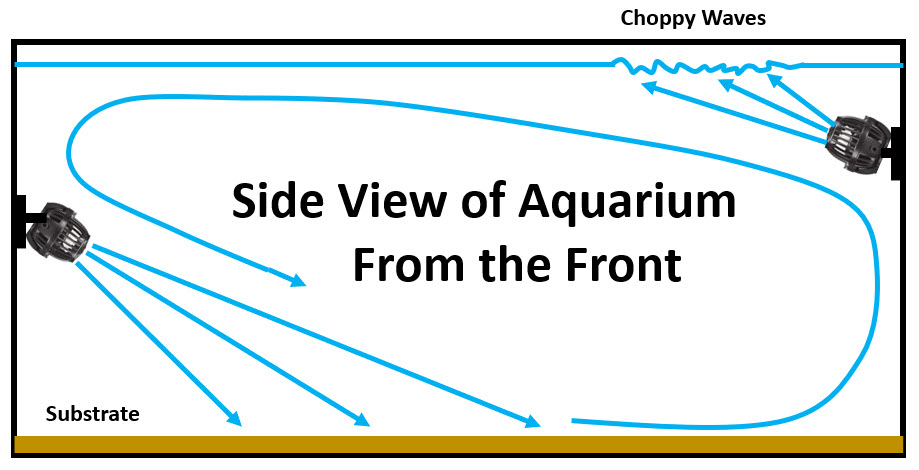
.
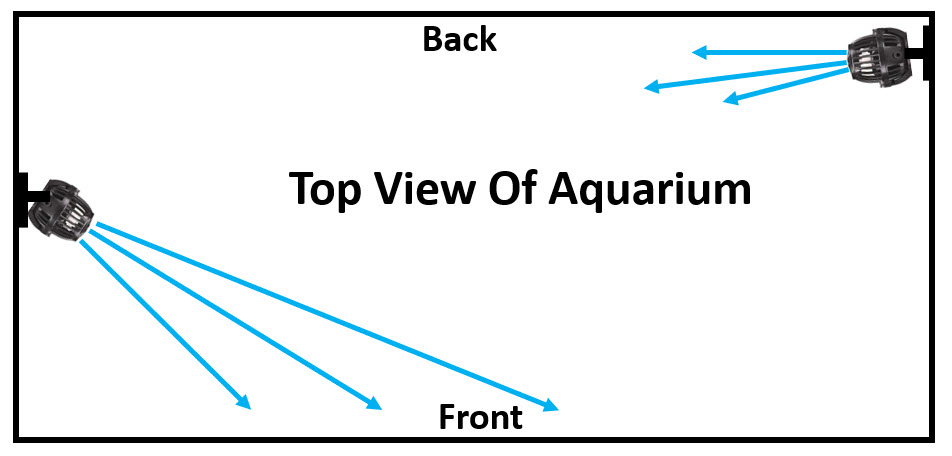
This two-pump arrangement gives a circular current in the aquarium which is just extremely beneficial to everything. Now obviously one has to take into account the size of the aquarium. While two bladed circulation pumps will do just fine for 50 to 100 gallon aquariums they would be a bit too much for a 20 gallon. Note also that bladed circulation pumps come in sizes ranging from 200 to 2,100 GPH.
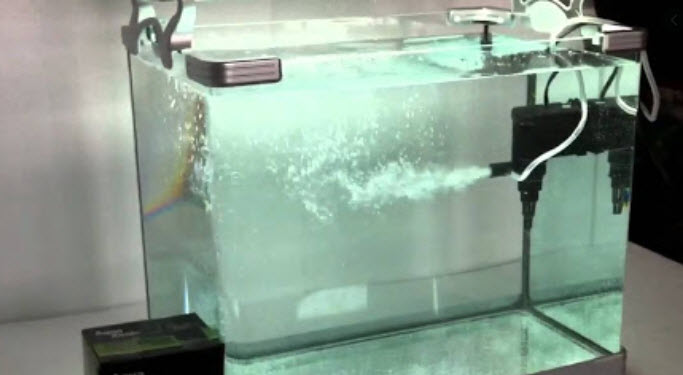
Powerheads
Powerheads are very useful to make cheap yet powerful filters for those hobbyists on a budget. If you replace the air on the lift tubes of under-gravel filters and sponge filters with powerheads on the top of the lift tubes, these inexpensive filters become “supercharged”. The additional flow created by a powerhead greatly increases the capacity of the filter.
What many don’t realize is that these powerheads give very good filtration for very little energy cost if placed on under-gravel filters. Most of my tankshave under-gravel filters with powerheads on them. A 4 watt powerhead on an undergravel filter is roughly the equivalent of a 35 watt pump on a canister filter. So you save that wattage. If you have a lot of aquariums this becomes important.
And an under-gravel filter is a superb filter as long as it is rarely or even never cleaned. It is a bad filter and a pain in the butt if it is cleaned often.
.
Return to Equipment Menu
.
Aquarium Science Website
The chapters shown below or on the right side in maroon lead to close to 400 articles on all aspects of keeping a freshwater aquarium. These articles have NO links to profit making sites and are thus unbiased in their recommendations, unlike all the for-profit sites you will find with Google. Bookmark and browse!
.

Dave says
In reply to Mike …. Yes the venturi will aide in aeration at the cost of a lot of noise.
Mike says
Hi Dave, I will be driving my UGF with 2 aquaclear 30 powerheads. These come with a air valve venturi. In your experience or opinion can the venturi on these powerheads aid with aireation?
emilia cohart says
i use a canister filter that is attached to an undergravel filter as an intake, should i use a pump to keep the substrate free of feces?
but the substrate is the only intake. i guess the pump would hide the feces to a spot below/behind the hardscape so that the substrate looks cleaner.